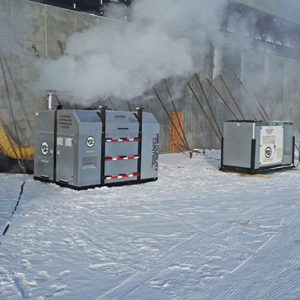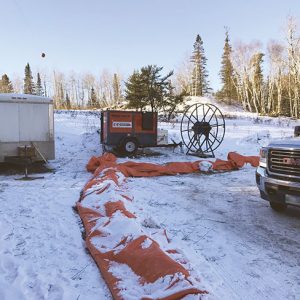
Efficient heat
By Treena Hein
Features Supplier stories Tech tips 2021 august canada efficient heat rentalThe latest on energy-efficient construction heating solutions.
 Indirect-fired units are placed outside the building or structure being constructed. They
generate heated air that is moved inside through ductwork. While the equipment is generally not moved during the project, the ductwork can be moved around as necessary.
ALL PHOTOS: cavalier industries
Indirect-fired units are placed outside the building or structure being constructed. They
generate heated air that is moved inside through ductwork. While the equipment is generally not moved during the project, the ductwork can be moved around as necessary.
ALL PHOTOS: cavalier industries Like any other powered piece of rental equipment, heating solutions for construction sites are now more energy efficient than ever. “The industry has been steadily increasing its focus on becoming more environmentally responsible,” says Ryan Grey, North American sales manager at Manitoba-based Tamarack Industries.
“You see it displayed on every jobsite with contractors using more and more battery-powered equipment, propane generators and Tier 4 Final diesel engines, to name a few. Heat has been an area where there has been significant improvement environmentally.”
Construction site heating systems come in three formats: electric, direct-fired and indirect-fired. Electric heaters can provide radiant heat or have a heating coil and fan. They certainly have their place in some applications, offering no emissions, good safety and simple use. However, they can be expensive depending on the electricity rate, model and space to be heated. They also aren’t an easy option at building sites in the early stages where electricity is not yet hooked up.
Direct-fired heaters burn propane or natural gas from portable tanks. They must be secured properly inside a building, caged and placed away from combustible materials. They also must be moved around within the building as needed. Indirect-fired units (also called central heating units or CHU) are placed outside and generate heated air that is moved inside through ductwork that can be moved as needed. They are typically not moved or moved very little during the life of a project. They can come in larger capacity format and use one or more fuels.
Dan Dimock, national sales manager at Alberta-based Cavalier Industries, notes that the use of propane and natural gas provides reduced emissions compared to diesel-fuelled heaters. “Respectively, this translates into a 10 to 20 percent CO2 reduction simply by changing fuel source,” he explains. “Unfortunately, diesel-fuelled equipment is still quite common.”
Having much more efficient heat exchangers and fans, however, maximizes fuel efficiency no matter what fuel is used, reducing emissions and operating costs for customers. Cavalier’s Eco Power Equipment provides high-efficiency multi-pass heat exchangers, which are more expensive, says Dimock, but he adds that “over 10 percent efficiency increases over the machine’s life can be translated into enormous fuel and emissions savings.” The most efficient heaters, he says, can have output adjusted to match application requirements.
To reduce their emissions, Tamarack customers are taking advantage of the firm’s natural gas/liquefied petroleum equipment where it’s available and practical. “Where it isn’t feasible to use those fuels, proper maintenance and installation is helping to keep the oil burners running as efficiently as possible,” Grey says.
In Wade Wilken’s view, when it comes to a construction site heating system that minimizes fuel consumption and carbon emissions, hydronic heat checks all the boxes. “Once the space is up to temperature, the hydronic system doesn’t have to consume as much energy because it only has to re-heat already warm inside air compared to other types of heaters that are always heating outside cold air,” explains the vice president of sales and marketing at Manitoba-based DryAir. “Pumping heated fluid from the CHU outside to thermostatically-controlled exchangers inside the structure allows for further gains in fuel efficiency. Once the space is up to temperature, the thermostats on each heat exchanger will turn the fans off. The fluid returns to the central heating unit hot and the CHU burner drops to a low fire, or cycles off completely until the demand for heat returns.”
Wilken also notes that systems that have warm air travelling through uninsulated ducts into a building have much more surface area exposed (and therefore more heat lost) to the ambient air before heated air arrives inside the building. DryAir uses rubber hoses which are much smaller and can be easily covered and insulated.
Tier 4 Final
In Grey’s view, transitioning to Tier 4 Final tech hasn’t been easy for the rental industry, with many manufacturers, rental operators and contractors having had difficulties with the new standard. “It isn’t going away, so now it adds new challenges for rental operators,” he says. “Generators, pumps and heaters have to be properly sized for the application or wet stacking can occur (when unburned fuel passes into the exhaust system and can cause a loss of performance, efficiency and in extreme cases, premature engine failure). Under our Thawzall brand, we currently manufacture a flameless air heater as well as a flameless glycol and air heater. Our design team has developed a state-of-the-art control system that properly manages the load on the engine to eliminate wet stacking.”
While these models are currently mostly used on oil and gas sites, with the increasing amount of “green’”initiatives popping up these days, Grey doesn’t think it’s a stretch to predict Tier 4 Final engines will be the future for general construction heat. This might take the form of a flameless air heater, a glycol heater or a Tier 4 Final generator powering electric heaters. “The industry isn’t quite at that point yet,” says Grey, “so currently we recommend proper sizing, installation and maintenance to help our equipment be as fuel efficient as possible.”
Wilken also encourages rental companies to discuss total operating cost of construction heat systems with their customers. He notes that because fuel is always the most significant expense when it comes to temporary heating, instead of presenting a contractor customer with just a quote on rental rates for the equipment, provide a proposal that shows BTUs required by heater type, fuel costs and rental rates for each type of heater. “With all of that information,” he says, “the contractor can make a fully-informed decision on the best solution.” DryAir dealers have access to the firm’s “temporary heating calculator,” which shows BTUs required by heater type (direct, indirect, hydronic and electric) and fuel estimates for each application.
Current and future technologies
Telematics (remote monitoring/control) is becoming more common with jobsite equipment and heaters are no exception. “The demand for telematics is increasing every year,” says Grey. “It has value to the rental operator as well as the contractor to be able to determine if their equipment is operating properly. A rental store can track and efficiently maintain their equipment that may have been out on rent for extended periods of time. Without proper maintenance, equipment reliability will suffer.”
Telematics can also be a fantastic tool for contractors to monitor their projects and log data,” says Dimock. “This data is imperative when using modern construction materials and ensuring that they are given the proper curing environment. This is especially key when dealing with warrantable failures.” Wilken echoes these thoughts. “In most applications, our equipment continues to run in the evenings and weekends when most jobsites are empty. The ability for site superintendents to check in on how the heating system is performing, or to receive low temperature alerts in real time, is critical. The technology has been around for a while, but it came at a significant cost and was not always reliable. Telematics systems are more reliable and economical today than ever.”
Print this page


Leave a Reply